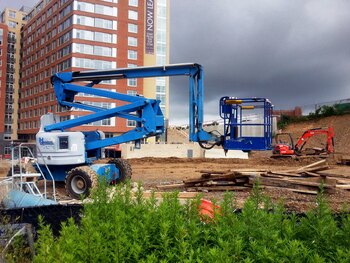
Lifting equipment is essential in many industries for moving heavy loads, increasing productivity, and enhancing workplace safety. From construction sites to manufacturing plants, lifting tools come in a variety of shapes, sizes, and mechanisms to cater to different lifting requirements. Understanding the different types of lifting equipment is vital for selecting the right tools for your specific needs. In this article, we’ll explore the main categories of lifting equipment, their uses, and the industries where they are most applicable.
1. Cranes
Cranes are one of the most recognized types of lifting equipment, used primarily in construction, shipping, and logistics industries. They come in various forms, including:
- Tower Cranes: These are common in urban construction for lifting materials like steel and concrete to great heights. Tower cranes are often fixed to the ground or attached to a building as it rises.

- Mobile Cranes: These cranes are mounted on trucks or crawler tracks, providing greater flexibility in transporting them to different job sites. They are typically used for lifting heavy loads in locations where a stationary crane would be impractical.
- Overhead Cranes: Also known as bridge cranes, these are commonly found in factories and warehouses. Overhead cranes consist of a hoist that travels along a horizontal beam, allowing for precise lifting and movement of materials within the confines of a building.
- Gantry Cranes: Similar to overhead cranes, gantry cranes run on a track system. They are often used in shipping yards to lift heavy containers and in construction to move large sections of buildings or machinery.
Cranes are versatile, offering solutions for both light and heavy lifting. However, they require skilled operators and regular maintenance due to their complexity.
2. Hoists
Hoists are another type of lifting equipment, typically used for lifting and lowering loads vertically. They are commonly employed in industrial settings, warehouses, and construction. Hoists can be categorized by their power source:
- Manual Hoists: These rely on human power to operate. They are equipped with a chain or rope and are often used for lighter loads in situations where an electric or hydraulic power source is unavailable or unnecessary.
- Electric Hoists: Powered by electricity, these hoists can lift heavier loads with greater speed and ease compared to manual versions. They are commonly used in workshops and factories for lifting loads such as machinery or equipment.
- Hydraulic Hoists: These hoists use hydraulic power, offering greater lifting capacity. They are often used in construction or automotive industries where heavy objects such as vehicles or components need to be lifted.
Hoists are typically used in confined spaces or indoor settings where vertical lifting is needed, and they are available in various sizes and load capacities to suit specific tasks.
3. Forklifts
Forklifts are versatile pieces of lifting equipment used primarily in warehouses, manufacturing facilities, and retail environments. They are essential for moving materials over short distances and lifting them onto shelves or into transport vehicles.
Forklifts come in several types, including:
- Counterbalance Forklifts: These are the most common type of forklift, with a counterweight at the rear to balance heavy loads lifted by the forks at the front. They are ideal for transporting goods in warehouses and construction sites.
- Reach Forklifts: Designed for warehouses with narrow aisles, reach forklifts have long arms that allow them to reach high shelves. They are perfect for operations that require vertical stacking of goods.
- Rough Terrain Forklifts: Equipped with large tires and more robust suspension systems, these forklifts are designed for outdoor use in construction or agriculture settings where the ground is uneven.
Forklifts are essential for material handling in many industries, and proper training is necessary to operate them safely and efficiently.
4. Winches
A winch is a type of lifting equipment used to wind a cable or rope in and out, thereby pulling or lifting a load. Winches are widely used in industries like construction, marine, and forestry. They can also be used for personal purposes, such as off-road vehicle recovery.
- Electric Winches: These are powered by electricity and are commonly used for tasks requiring frequent, repetitive pulling or lifting. They are often installed on trucks or in industrial facilities.
- Hydraulic Winches: Using hydraulic power, these winches are suitable for heavier loads and are used in more demanding environments like oil rigs or shipyards.
- Manual Winches: These require physical effort to operate and are generally used for smaller, lighter loads. They are common in boat trailers, garages, and small construction projects.
Winches offer a versatile solution for both horizontal and vertical lifting, and they can be portable or stationary depending on the application.
5. Lifting Slings
Lifting slings are flexible, portable lifting devices made of fabric, chain, or wire rope. They are used to lift loads in combination with other lifting equipment, such as cranes or hoists. Slings distribute the weight of a load evenly, minimizing the risk of damage to the lifted item.
- Chain Slings: These are strong and durable, used for lifting heavy, abrasive loads. They are often found in industrial settings like steel mills or construction sites.
- Wire Rope Slings: These slings are flexible yet strong, making them suitable for lifting loads in environments where abrasion is a concern. They are commonly used in marine and construction industries.
- Synthetic Slings: Made from materials like polyester or nylon, synthetic slings are lightweight and gentle on delicate loads. They are often used in industries like manufacturing, where protecting the surface of a load is important.
Lifting slings come in various configurations, such as single, double, or multi-leg designs, depending on the weight and nature of the load.
6. Hydraulic Jacks
Hydraulic jacks are lifting devices that use hydraulic power to lift heavy loads over short distances. These tools are common in automotive repair shops and construction sites for lifting vehicles, machinery, or other equipment.
- Bottle Jacks: These jacks have a cylindrical body and can lift heavy loads to higher heights compared to other types of jacks. They are widely used in the automotive industry for lifting vehicles.
- Floor Jacks: These are low-profile jacks often used in garages to lift vehicles. They are mobile, making them easy to position under the load.
Hydraulic jacks offer powerful lifting capabilities, but they are typically limited in the height and distance they can lift.

7. Scissor Lifts
Scissor lifts are a type of aerial work platform that can vertically raise workers or materials. They are widely used in maintenance, construction, and manufacturing industries to access high places safely.
- Electric Scissor Lifts: These are quieter and emission-free, making them suitable for indoor tasks like maintenance or warehouse operations.
- Rough Terrain Scissor Lifts: Designed for outdoor use, these scissor lifts have rugged tires and stronger lift capacities to navigate uneven surfaces.
Scissor lifts provide a stable platform for workers and are essential for tasks requiring work at height.
Conclusion
Lifting equipment plays a crucial role in improving efficiency and safety across multiple industries. From cranes and forklifts to winches and jacks, each type of equipment has its specific applications and advantages. By understanding the capabilities and limitations of each, businesses can select the most suitable equipment for their needs, ensuring both productivity and safety on the job site.
Choosing the right lifting equipment not only enhances operational efficiency but also protects workers and the materials they handle, making it a critical decision for any industrial operation.

Leave a Reply